Benoit Lahaye >
Champagne >
France|
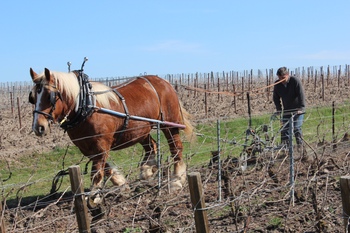 |
| Benoit Lahaye is located in Bouzy, a Grand Cru village in the Montagne de Reims region. His family has been making Champagne since the 1930’s, and he and his wife Valérie now work in their winery with their two sons. The estate covers a tiny 4.8 ha, with 3 ha in Bouzy, 1 ha in Ambonnay and .6 ha in Tauxières. Bouzy brings structure, power and fruit, while Ambonnay brings acidity and roundness. The vineyards are mainly planted with Pinot Noir (just under 90%) on south/southwest facing slopes. The vines average 35 to 40 year old. In addition, a .2 ha parcel of 50 year old Chardonnay is planted in Voipreux, in the southern Côte des Blancs. Since it is far away from Bouzy, these vines are worked by Pierre Larmandier. The total production is less than 40.000 bottles per year.
Farming practices: In 1995, Lahaye took the decision to allow grass to grow in the totality of the vineyards. He works the soil in order to aerate it and limit competition regarding water intake by the vines during certain periods of the year. The estate is fully organic since 2003, and 2007 was the first vintage Certified Organic. Lahaye only uses his own compost, and also some organic manure as a complement. Various herb infusions are applied, along with other fermented extracts from plants, copper-based (in regulated quantities) and sulphur-based preparations, and essentials oils in order to combat plant disease. Since 2009, Lahaye has been applying the principles of biodynamic viticulture to further the every-day work, improve the characteristics of the terroir, and reveal the full potential of the soil and the vines. Benoît says that the switch to biodynamic practices has brought higher potential alcohol at harvest, but also higher acidity and more anthocyanins. Tamise, a 7 year old working-horse from the Auxois breed, joined the team in 2010. Tamise helps in the vineyards, from ploughing to spreading the compost or picking up the frames. Since 2010, the estate has been certified as biodynamic by Biodyvin.
In the cellar, the work is as minimal as possible. The major part of the vinification is achieved in Bordeaux (225 liters) and Burgundy (228 liters) oak barrels. Only natural yeasts are used, and no chaptalisation is done - a practice conducted by many estates. The wine is aged for 10 months on the lees without any racking. All the wines now go through malolactic fermentation: with the biodynamic practices, they have enough acidity and fruit to go through it, and it is not necessary anymore to stop the malolactic fermentation by adding sulfites. The barrels are in a building with windows, so that the wine "sees the seasons" before being bottled. As of the 2012 harvest, all base wines are fermented in barrel. The wine is bottled on a fruit day, or sometimes on a flower day. All the bottles are turned over with gyropalettes. There is no difference with manual riddling, and it allows to gain time and be in the vineyards when there is a lot of work to be done there. The bottles stay 7 days in the gyro for stabilization, before the 7 days riddling process. Since 2008, Lahaye has been experimenting with making wines without the addition of sulfur, bottling a "sans soufre" cuvée called Violaine.
Farming practices: Certified Organic and Certified Biodynamic. |
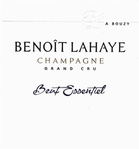 |
| Brut Essentiel |
90% Pinot Noir, 10% Chardonnay. 80% of the grapes come from Bouzy, and 20% from Ambonnay. The soil is brown chalk – Planting density: 8400 plants per hectare - Root-stock: 41B – Pruning type: Cordon Royat and Chablis – Average age of vines : 35 years. The parcels are vinified separately. The wine is aged for an average of 30 months on the lees, with 1 or 2 stirring. Bottled without filtration. Not all the bottles are degorged at the same time. Dosage: 6gr/liter - 500 cases produced and 300 magnums, 800 half-bottles.
"Compared to the Brut Nature, this is much more flowery and fruity in aroma, its 6 g/l of dosage bringing out notes of red cherry, peach and red currant. It feels very typical of Bouzy in its forward, voluptuous fragrance, but it also shapes its ripeness well, finishing with focused, refined flavors. It’s an excellent non-vintage brut." Peter Liem
|
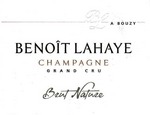 |
| Brut Nature |
90% Pinot Noir, 10% Chardonnay. 80% of the grapes come from Bouzy, and 20% from Ambonnay. The soil is brown chalk – Planting density: 8400 plants per hectare - Root-stock: 41B – Pruning type: Cordon Royat and Chablis – Average age of vines : 35 years. The parcels are vinified separately. Aged for an average of 30 months on the lees, with 1 or 2 stirring. Bottled without filtration. Not all the bottles are degorged at the same time. No Dosage. No addition of SO2. 500 cases produced and 200 magnums.
"Lahaye releases his non-vintage champagne as both a Brut and Brut Nature, but the Brut Nature is by far the more sought-after by those in the know. Based heavily on pinot noir, which can account for as much as 90 percent of the blend, it always includes a high percentage of reserve wines (sometimes as much as 50 percent), and is typically a blend of four-fifths Bouzy and one-fifth Ambonnay. Lahaye credits the balance and complexity of his Brut Nature to the elevated ripeness attained by organic farming. “In the past it wasn’t possible to make a Brut Nature like this,” he says, “but after working organically we can do it.” Peter Liem
|
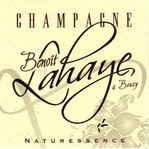 |
| Brut Naturessence |
50% Chardonnay and 50% Pinot Noir. Up until 2002, Lahaye made a vintage-dated prestige cuvée called Fleur de Terroir, made of equal parts Pinot Noir and Chardonnay. This has evolved to become the Naturessence, and is now blended from different years, although it is still sourced from old vines in Bouzy and Ambonnay for the Pinot Noir, and Voipreux and Tauxières for the Chardonnay. The soil consists of brown chalk. Planting density : 8400 plants/hectare. Root-stock : 41B and Fercal. Pruning type : Cordon de Royat and Chablis.
The Pinot Noir and Chardonnay grapes are pressed separately. Bottled without filtration. Dosage : Extra-Brut (4-5 gr/litre). 233 cases made.
|
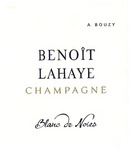 |
| Blanc de Noirs (formerly called Brut Prestige) |
100% Pinot Noir from Bouzy ("Les Vaux Bétins" and "Les Hannepés" plots with deep soils) and Tauxières, in an area called "Les Argentières", with more chalk - vines planted in 1960, 1980 and 1990. Planting density: 8400 plants/hectare. Root-stock: 41B. Pruning type: Cordon de Royat.
The grapes from each parcel are pressed separately. No filtration. Dosage : 5 gr/liter (Extra-Brut).
Dark-toned fruit is underlined by a stony minerality. Energetic and persistant through the finish. 666 cases produced.
|
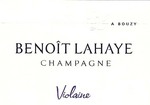 |
| Cuvée Violaine - Sans Soufre |
The first cuvée of Violaine was 2008. 50% Pinot Noir and 50% Chardonnay, from vines planted in 1989 and 1990 - 50% from “Les Argentières” (Tauxières) and 50% from “les Monts des Tours » (Bouzy). The soil consists of brown chalk - Planting density: 8400 plants/hectare - Root-stock: 41B - Pruning type: « Cordon de Royat » and « Chablis ». The grapes are pressed separately for the two parcels, without sulfite. 1 or 2 stirring of lees ("bâtonnage"). Bottled without filtration. No sulfite added. No dosage. 150 cases produced.
"The wine is luscious and alluring with bright energetic fruit showing depth and purity of flavor. Its soil notes are as equally intense as its fruit presence. Both persist with multi dimensional fragrance and length. This outstanding wine unfolds in the glass, revealing new facets as it evolves." Peter Liem
|
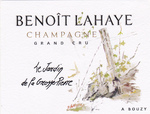 |
| Le Jardin de la Grosse Pierre |
100% from Bouzy Grand Cru.
Soil: Brown chalk - Root-stock: 4lB - Planting density: 8400 plants/hectare - Pruning type: Chablis.
Field blend of Pinot Noir, Pinot Meunier, Pinot Blanc, Chardonnay, Arbanne, Chasselas, Petit Meslier , Gros Plant, Teinturier and other varieties.
This cuvée is named after the single parcel of the same name. The oldest vines were planted in 1923 by Benoit's great grandfather, at a time when vineyards were inexpensive. The vines in Champagne usually average 30 year old and it is a rarity to have vines that are as old as 90 years. In 1952, Benoit's grandfather replaced some dead vines by other varieties, some unknown or now forgotten. Combined with the age of the vines, this diversity gives the wine a great complexity and rare aromas. Until 2009, the wine made from this parcel was blended with wine from other parcels. After tasting it separately, Benoit recognized its unique character and decided to make a special cuvée from it. The 2009 vintage was aged for 10 months in 225l old barrels, bottled in July 2010 without filtration, then kept an extra 28 months in bottles before release. No Dosage. 140 cases made.
|
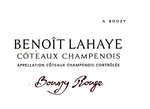 |
| Bouzy Rouge |
100% Pinot Noir from vines planted in 1960. The soil consists of brown chalk which is quite deep. Planting density: 8400 plants/hectare. Root-stock: 41B. Pruning type: Cordon de Royat. No chaptalisation. Whole clusters, some punch down and pumping over.
Malolactic fermentation in oak barrels (second to third use) until spring 2013. The wine is then aged in oak barrels, without any racking process, until September 2014. Bottled in February 2015. 100 cases made.
|
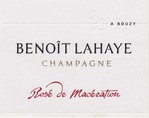 |
| Rosé de Macération |
100% Pinot Noir from “Les Juliennes”, a vineyard located on the terres blanches in Bouzy, on the border with Tauxières, and planted in 1973. Shallow, brown chalk soils. Planting density: 8400 plants/hectare. Root-stock: 41B. Pruning type: Cordon de Royat.
Whole cluster maceration for 2 to 3 days, then direct pressing. The still wine is racked once and not filtered before its secondary fermentation. Low dosage of 2 to 3 grams/liter (extra dry). Production: 4000 bottles.
|

